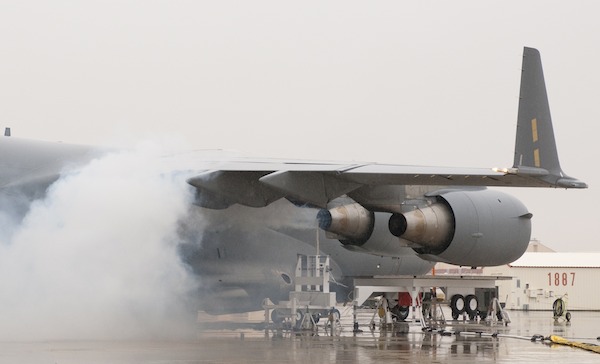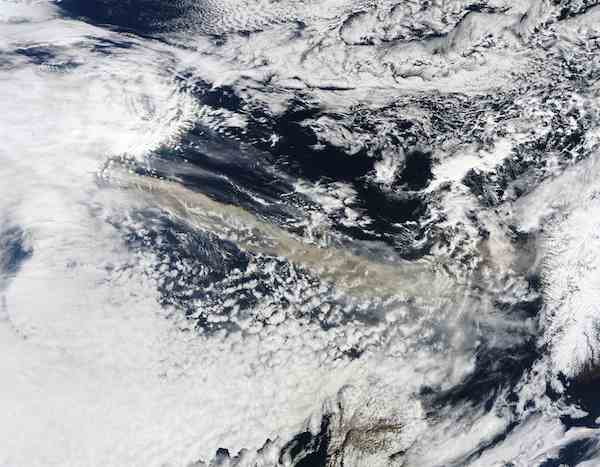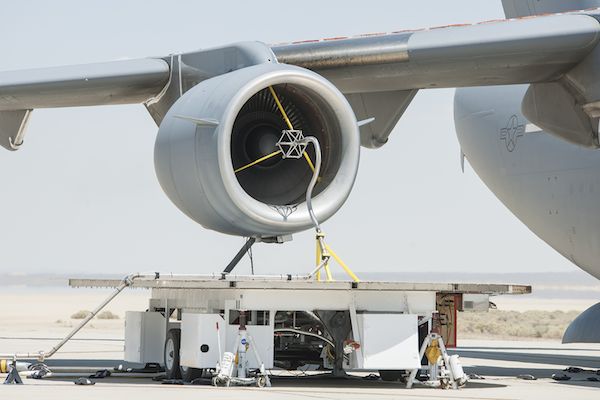
[Image above] Oil smoke billows from the right inboard engine of the C-17 while a probe collects emissions data during 2011 VIPR engine health monitoring tests. Credit: NASA Armstrong
When a volcano erupts, we usually think about all the problems that beautifully dangerous red-hot lava causes. But eruptions cause problems for more than just those in the path of scorching lava flows.
The 2010 eruption of Eyjafjallajökull in Iceland disrupted the lives of about 10 million people who had booked travel on hundreds of flights across Europe over a span of almost a week.
That’s because volcanic ash spewed into the air is a big problem if it gets sucked into airplane engines, where the hot environment—like that created by volcanic lighting—can turn the ash into glass.

The ash plume (brown streak) from the 2010 volcanic eruption of Eyjafjallajökull. Credit: NASA Goddard
“The primary issue is that volcanic ash forms glass in the hot sections of some engines,” John Lekki, NASA Vehicle Integrated Propulsion Research (VIPR) principal investigator, says in a recent NASA press release. “This clogs cooling holes and chokes off flow within the engine that can eventually lead to an engine power loss. It is very erosive, which causes damage to compressor blades and other parts in the engine.”
Watch the BBC One video below to see a lab-scale demonstration of how that glass builds up on turbine blades, and how pilots can reverse its formation.
Credit: BBC; YouTube
Previous research has attempted to identify how the particle size of volcanic ash affects deposition in small jet engines, but nothing compares to the real deal.
So scientists at NASA have taken measurements of what happens in full-scale tests—in which the scientists injected actual volcanic ash into an operating jet engine—and will spend the next several months analyzing the experimental data.
The simulation is the latest in a long string of experiments spurred after the eruption of Eyjafjallajökull to gain a better understanding of what happens when an engine encounters airborne ash and how sensors could better monitor engine health in these encounters and during everyday travel.
“We don’t know of anybody who has ever attempted to introduce volcanic ash directly into the engine core on the wing of the airplane in a controlled way,” Paul Krasa, VIPR project manager, says in the release. “We needed to do that because we really needed to understand the full system effect.”
Earlier tests in the project had ensured the sensors’ sensitivity and ability to detect debris using cereal and crayons, “materials that wouldn’t harm the engines,” the release states.
Those earlier experiments set important parameters and baselines that allowed the researchers to work up to destroying a full-scale jet engine.
The latest test culminated those preliminary experiments by blowing actual volcanic ash directly into running F117 engines (military equivalents to commercial 757 engines) mounted to a C-17 cargo transport. A large engine-mounted rig called a spider injected the ash at low and high flow rates to measure how the ash would affect the engine.
The setup sounds rather simple, but the tests were anything but—that’s because volcanic ash is crushed pumice, which is really, really abrasive.
“One of the things we found out was that the original volcanic ash distribution rig we were using to introduce the ash into the engine ate itself,” Krasa says in the release. “Volcanic ash literally has such an erosive characteristic to it that it was able to cut through fittings, so we had to go though a redesign.”

The volcanic ash distribution spider, shown here in the inlet of the engine while running, was used to send the ultra-fine particles of ash through the engine. Credit: NASA Armstrong
Redesigning the rig worked, although the abrasiveness of the ash was still evident.
“What you could see was the erosion on the inside of the blades—a cleaning of the blades,” Krasa says. “The ash never really degraded the blades, but you could see how they were really clean the first couple of inches.”
Beyond the turbine blades, the ash had a bigger effect inside the jet engine.
“As the powder comes through the hot section, it actually turns into very, very small volcanic glass droplets,” Krasa says. “You see a huge amount of this glass accumulating on the inside of the engine.”
“There was erosion in the compressor and ‘glassification’ in the turbine,” Lekki adds.
Preliminary observations provided a clear picture of what was happening inside the engine, although further analysis of the data is ongoing. According to the release, the team is planning on making the results publicly available by summer 2016.
The other part of the engine testing, besides the effect of volcanic ash, is the smart sensor system that NASA is developing to take advanced diagnostics from within jet engines.
“Improved sensors also could identify changes in vibration, speed, temperature, and emissions that are symptomatic of engine problems before they become serious safety concerns. Notifications would be provided to ground crews of potential problems that could be fixed by preventive maintenance or alert pilots to changes in engine health thereby allowing time to prevent engine damage in flight,” according to a separate NASA press release about the sensors.
The research is a collaboration of NASA with various other government agencies and industry, including the Federal Aviation Administration, the U.S. Air Force Research Laboratory, Pratt & Whitney, Rolls Royce Liberty Works, General Electric Aviation, and Boeing Research & Technology.
